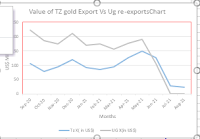Why did Tanzania export gold via Uganda and Burundi in 2020?
According to the Bank of Tanzania, the country earned US$2.9 billion from gold exports last year. This, the bank says, was a 32 percent increase over the $2.2 billion earned the previous year. According to Tanzania invest, the major destinations for Tanzania’s gold exports are South Africa, Switzerland, and India. However, multiple reports indicate that Tanzania used her neighbors, Burundi and Uganda, to export her gold last year. The reports do not explain the shift of destinations to the Middle East via her neighbors. It does not explain the sudden change in consumer behavior in Uganda and Burundi, two countries teetering on poverty, from basic goods to luxuries such as gold.
Neither do they explain why Tanzania could not export her
gold directly to the market This leaves some hanging questions such as; Did
the closure of Airports and Seaports shut the doors to Tanzania’s exports? Was
she magnanimous to her neighbors in dire straits? or was she afraid, afraid of
what? What was the effect of her indifference to the COVID-19 pandemic on her
gold exports?
 |
| Gold Exports declined to Zero in July 2021 |
Uganda and Burundi’s gold re-exports increased significantly
between May last year, and sometimes this year. According to the Economic Performance Report published
by Uganda’s Ministry of Finance and
Planning, between September 2020 and June 2021, Uganda imported Gold worth
$1.095 billion from Tanzania and exported gold worth $1.8 billion over the same
period. It is not clear how much gold Tanzania exported to Burundi.
It is also not clear
how much gold Tanzania had exported to Uganda before the dates published in the
EPR. However, the East Africa Trade
Report, published by TradeMark East Africa last year, shows that Extra-EAC
trade in Burundi and Uganda began rising in June 2020. Extra-EAC trade refers
to exports to the rest of the world. These
sudden rises, says TMEA, were in “correlation to increase in mineral exports.”
The TMEA report shows that Burundi’s extra-EAC trade was
minus 7 percent in May 2020. It then
rose to 67 percent in June, and to an astonishing 804 percent in July before
declining to 52 percent in September 2020. Over the same period, Uganda’s
Extra-EAC trade rose from minus 54 percent in May 2020 to 15 percent in June
and then to 31 percent in July, then 16 percent in October.
From these reports, it seems, the $2.9 billion Tanzania earned
from gold last year was exported to Burundi and Uganda. It is worthy of note that trade in gold in
Uganda declined to zero from July this year when the government imposed taxes on
gold exports. Imports of gold from Tanzania also stopped.
Uganda’s aggressive COVID-19 control measures severely
hurt her economy, we can report. According to the African Economic Outlook
(AEO) 2021, Uganda’s economy shrunk to negative territory, posting a minus 0.5
growth.
Yet, the country’s recorded exports of gold, $1.8 billion are
nearly six percent of the country’s GDP. That these massive exports had no effect
on the domestic economy suggests that the country was just a transit route for
gold produced elsewhere. This theory is lent credence by the fact that Uganda
imposed a 5-10 percent tax on gold exports.
Soon thereafter, the business collapsed pushing Tanzania to
the second slot of leading import sources after Kenya. Earlier this year,
Tanzania had dethroned Kenya from the top perch. Since May 2021, however, Kenya
has reclaimed its position as the leading source of Ugandan imports in EAC, and
also, the leading destination for her exports.
The recession in Uganda cost the productive sectors dearly due to the collapse of domestic
demand. The informal traders, says the East
Africa trade report, lost US$43 million as their businesses shrunk to just
$1 million from the previous $44 million a year.
Consequently, domestic demand receded leading to deflation. In January
this year, deflation hit minus 6 percent, then turned north. It is still in the
negative territory.
Deflation is the situation of persistent price declines for a
long time. It is a situation of declining domestic demand amid an increased
supply. Therefore, producers dump their produce to jerk up demand.
The depressed domestic demand in Uganda, coupled with a weak
currency was perhaps, the cause of frequent trade spats with Kenya, her leading
African market. Since December 2019,
Kenya has banned imports of Ugandan agricultural produce, such as Sugar, Maize,
milk, and poultry products.
Although Kenya cited quality and health concerns, it seems,
the real reason was to protect Kenyan produce from dumped Uganda produce.
The reasoning is simple: Uganda’s domestic market was depressed.
Consequently, producers reduced prices to jerk up demand. This made them
cheaper compared to similar goods produced in Kenya. If Cheap Ugandan goods
crossed the border into Kenya, they could elbow similar Kenyan produce out of
the domestic market or force the producers to sell at a loss. That is politically and economically
unacceptable.



Comments
Post a Comment